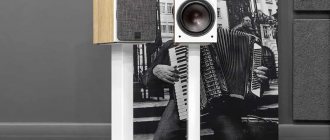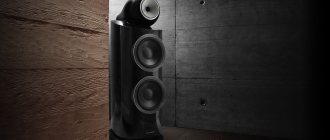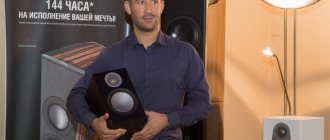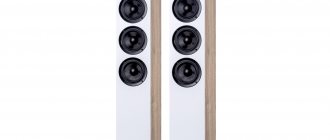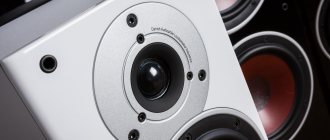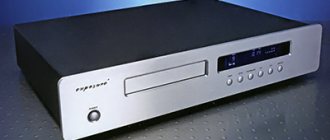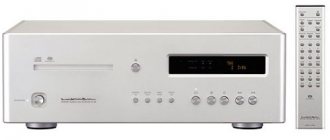In the tradition of DALI and, in fact, the Ikon series, the speakers have a smooth, musical sound, deep bass, and besides, they are not at all demanding on the amplifier. However, in pursuit of sound comfort, Ikon 8 excessively smooths out small details of timbres and the speed of time transitions. These speakers crown the extensive Ikon line, logically being the largest representatives of this family.
Test: Denis GONCHAROV, Consumer magazine. Video&Audio
Design
Like other models in the series, Ikon 8 is equipped with a hybrid high-frequency module consisting of two emitters mounted on a common panel. In the range from 3 to 20 kHz, a tweeter with an enlarged fabric dome with a diameter of 28 mm operates; frequencies from 14 kHz and above are voiced by a ribbon tweeter measuring 17x45 mm.
The dome tweeter uses a rear damping chamber, and the emitter coil is cooled using ferromagnetic fluid. The use of two HF emitters at once makes it possible to expand the directional pattern of acoustic systems; DALI developers consider this quality to be one of the most important.
Ikon 8 midrange/bass speakers: two woofers with a diameter of 200 mm and a mid-frequency driver with a size of 165 mm. The speakers are equipped with a cast aluminum chassis and motors with a dual magnetic system. A rear magnet with reverse polarity provides speaker shielding.
Baskets with narrow ribs are well ventilated and do not cause noticeable air compression behind the membrane. The cones are made from pressed paper reinforced with wood fibers and are mounted on low-loss rubber surrounds to ensure low distortion at extreme amplitudes.
In Ikon 8, all midrange/bass speakers are mounted in isolated chambers: the midrange driver is placed in a closed compartment, the bass boxes are designed like a bass reflex: the port of the lower woofer goes to the front panel, the port of the second woofer faces back.
The Ikon 8 crossover is assembled manually on two vibration-proof boards. The mid/high frequency part of the crossover is placed in the mid-frequency speaker compartment, the low-pass filters are connected directly to the input terminals. The components of the crossover filter circuit are selected for maximum linearity of the frequency dependence of the impedance. As a result, Danish speakers are not so demanding on the power amplifiers used.
The Ikon 8 cabinet is finished with black or light walnut vinyl film.
Speaker systems DALI Ikon 7 review
DALI is known for its high-tech developments - for example, ribbon tweeters and generally high-quality acoustics.
Speakers with four bands, a feature of the speakers in a hybrid HF module, which consists of two speakers. The fabric dome provides frequencies from 3 to 20 kHz, and the ribbon super tweeter starts working from 14 kHz and up to 30 kHz. This design is used in the company's older models. The material of the woofer diffusers is traditional - cellulose with wood fibers; the speakers are equipped with a cast aluminum chassis and dual magnets. The body material is MDF, inside there are bulkheads trimmed with sound-absorbing material. The front panel is finished with vinyl film, the total thickness of the two-layer panel is 20 mm. The bass reflex is located at the front, and the two gold-plated pairs of terminals on the rear stack are very convenient to connect.
The sound of the speakers has good detail and subtle after-sounds, the contribution of the ribbon tweeter is felt, the speakers have fundamentally different treble frequencies than speakers with a conventional tweeter. The speakers play classical music very beautifully - proportionately and emotionally. The proportions are well adjusted, the game is a little soft and exciting. Piano parts sound good - with excellent texture development, dense low frequencies in the strings, which are worked out quickly and with precision. The only negative concerns the academic vocals - they sound a little compressed, but the rest of the vocals are reproduced very well.
Rock and metal sound very intelligent and with a little softness with good rhythm and dynamics, the drums just lack a little harshness. While listening, you get the feeling that the speakers sound better than their price.
The resulting speakers have very detailed high frequencies and excellent timbral balance; the downside is a slightly softened presentation.
The speakers cope very well with the classics - they play them softly and harmoniously, the timbres, balance and resolution are at a very decent level, the speakers are especially good at high frequencies. The speakers don't handle energetic music very well.
The frequency response shows a slight decrease in sensitivity at the beginning of the high-frequency range and a smooth and significant increase in sensitivity at the top of the octave. This can be corrected by listening to the speakers 30 degrees horizontally and slightly lower relative to the tweeter axis - the frequency response will miraculously level out. The sensitivity of the speakers is quite high - 91.5 dB. The impedance is highly stable - the minimum is 4.9 Ohms, the average is 6.9 Ohms. The SOI is very low throughout the region.
Passport details:
Type – floor-standing speaker systems Name – DALI Ikon 7 Frequency response, Hz – 36–30,000 (level +/-3 dB) Number of bands – 4 (LF/MF – 3 x 16.5 cm, cellulose; HF – 2, 8 cm soft fabric dome + ribbon super tweeter 1.7 x 4.5 cm; crossover frequencies 600, 2900 and 14,000 Hz) Acoustic design – bass reflex Impedance, Ohm – 6 Sensitivity, dB – 92 Dimensions of one speaker, cm – 114 x 20 x 34 Weight of one column, kg – 22.9
786 total views, 1 views today
- Speaker systems Dali Spektor 1 review
- Acoustic system Dali Zensor 1 - review
- Speaker systems DALI Opticon 5 review
- Stereo receiver Onkyo TX-8270 review
- A/V receiver Denon AVR-X250BT review
- Blu-ray player Panasonic DMP BDT 460 review
- A/V receiver Denon AVR X1500H - review
- Speaker systems Polk TSX-220B review
Sound
In general, the sound of Ikon 8 retained all the positive features characteristic of the speakers in the series - in recent years, Ikon speaker systems have participated in our tests more than once. Like other iPhones, the 8th models have an even tonal balance, you just need to install them correctly - the speakers do not need to be turned towards the listener, just point them parallel.
Other advantages of Ikon 8: detailed, smooth top, airy music stage with volume and good localization. The slightly warm musical middle naturally conveys the main timbres of instruments and emotionally conveys vocal parts.
The enhanced bass equipment of the Ikon 8 line, compared to the “junior” floorstanding speakers, has led to a clear expansion of their operating range in the low-frequency region. Subjectively, the speakers capture even part of the lower bass, while the bass is reproduced quite texturedly and with good control, the speed of the bass deteriorates only at the very bottom.
Although we did not notice any major errors in the sound of the Ikon 8, there are still minor flaws. For example, the localization of images in the frontal area of the scene is better than in the depth of the stereo image, and in the center of the picture - better than at the edges. The speakers somewhat obscure the layer of micro-amplitude information and slightly soften the articulation of sound. Perhaps, with excellent sound comfort, Ikon 8 is inferior to the best loudspeakers in its class in sound timing.
Price : 66,100 rubles.
Dali Ikon-7
Acoustics price category about 2t. evergreen dollars, when listening and comparing with the 35 AC Radiotehnika S-90F, , it turned out to be not up to par. The sound of the Dali Ikon-7 was not expressive and dull, there was no dynamics and the sound was a complete mess. The only thing that tried to sound was the high frequencies, due to the super tweeter. There is simply nothing to say about everything else. The owner of these Dali Ikon-7 simply wilted and, without saying anything, simply threw up his hands and really liked the sound of the 35-ac Radiotehnika S-90F, . The 35s were let down by very high frequencies due to nonlinear distortions and after-sounds (clacking and hissing), which was affected by the work of the 6GDV-6-25 speaker.
We agreed to hold an audition in two weeks.
The Dali Ikon-7 uses all the innovations described in popular literature: spikes are used, a painted nameplate is pasted on, dome and isodynamic emitters are used in the HF unit, two boxes are used in the speaker design (this is the impression that a bookshelf speaker was placed on a woofer speaker and combined into one speaker) .
3 weeks have passed, as they say, soon the fairy tale is told, but it won’t be done soon. I had to tinker with the Dali Ikon-7, and this was done:
1. The low-pass filter has been replaced and matched with the frequency response of the speakers. 2. The midrange filter has been replaced and matched with the frequency response of the speaker. 3. The high-pass filter has been replaced and matched with the frequency response of the speaker. 4. The Super HF filter has been replaced and matched to the frequency response of the speaker. 5. The volume of the LF box has been increased from 30 liters. up to 40l. 6. The resonant frequency of the woofers has been reduced from 46-48Hz to 36-39Hz. 7. The midrange box is damped. 8. The bass reflexes are configured. 9. A clear four-way system has been created.
The work yielded results, the acoustics sounded great. the 35 speaker Radiotehnika S-90F, which was modified with an average upgrade .
Modified speakers:
N1 Dali Ikon-7 N2 Dali Ikon-7 N3 35 AC Radiotehnika S-90F
The difference between N1 and N2 is in the filters and the connection of the low-frequency speakers. Preference for the sound at mid and high frequencies was unanimously given to the N1, but the low frequencies sounded better on the 35 AC, the speaker cone area and the volume of almost 50 liters gives its result (the mid frequencies of the 35 AC were not much inferior in sound quality to the N1 Dali Ikon-7) .
The N2 Dali Ikon-7 sounded good, but it didn’t have the same dynamics and expressiveness in the sound of mid frequencies (soloists’ voices, vocals, string instruments).
N1 Dali Ikon-7 sound expressive and clear. The vocals of the soloists (men and women) sound natural, pure and natural. The copper in the sound of the cymbals of percussion instruments is pure, without overtones or clicking (no after-sound).
N3 modified with an average upgrade of 35 speakers Radiotehnika S-90F sounded at the level, they greatly let down the high frequencies, but the Dali Ikon-7 could not reach the level of low frequencies of 35-k.
In my opinion, if you add a high-frequency unit with a Dali Ikon-7 to the 35s modified according to the average upgrade, you will get acoustics in the 2t price category. evergreen dollars, decent sounding.
To the modified No. 1 Dali Ikon-7 you just need to add a good subwoofer that would reproduce the lowest frequency range from 20-30Hz to 100-200Hz, and you will get a good set for a music lover, for whom music plays one of the dominant roles in life. The acoustics sounded decent and, when compared with other speakers in this price category, will take their rightful place among the leaders in high-quality and accurate sound. On this speaker you can compare the quality of recorded CDs (if you have a good CD player and amplifier). We listened to the Dali Ikon-7 with a Victor AX-1100 amplifier and different sound sources.
Conclusion: Not everything sounds like it’s worth a lot; to paraphrase the famous proverb, all that glitters is not gold. Before you buy, listen and see what you are buying or look for a good master who will bring the speakers to good sound.
This is interesting to read:
Modernization of the Radiotehnika U 101 amplifier Comparative listening of crossovers Comparative listening of 35-AS and Pioneer CS-9030
- < Back
- Forward >
Comments
+17 master 01/09/2018 22:29 My respect. These speakers have had a lot of alterations and improvements, so the price was somewhere around $500, or rather I don’t remember, it was altered in 2010.
Quote
+1 Dmitry666 10/16/2017 17:44 Good afternoon. How much does such a modification of 7 Icons cost?
Quote
+41 Igor 01/07/2013 16:34 I’ll continue: a real person from those who understands and can improve the sound (possibly the only one in Abakan, there was a bitter experience with other masters - sheer hackwork). I gave my Victor AX-1100 amplifier to the Master for conversion from 100V to 220V and repair one channel. Two weeks passed. The master asked to bring speakers to match the amplifier. My expensive Dali Icon-7 speakers work fine, should I harmonize them? The master persuaded me to bring speakers; at his house my Victor was connected to a 35AC Radiotehika S-90F. He asked me to determine which sound I liked best. After listening to the left and right speakers, there was no doubt; the left one sounded more natural and open, as if without a curtain. Instead of the right speaker, we connected a Dali Icon-7; the highs were at their best, no doubt about it, but the mids and bass were dull and not expressive, I asked how from this g... we got such a sound??? 35AC costs 5 thousand rubles, and mine costs 50 thousand rubles. and they play worse. To which the Master replied, upgrade, configure and coordinate the operation of the speakers and filters, in a week your Dali Icon-7 will start singing.
Quote
Update list of comments RSS feed of comments for this entry
Add a comment
Measurements
A signature feature of Ikon 8 is a very smooth and stable impedance, varying from 4 to 9 ohms in the mid/high frequency region, not falling below 4 ohms throughout the entire frequency spectrum of measurements. The bass reflex is set to a low frequency - 28 Hz. Judging by the “tremor” of the curve in the midrange, the Ikon 8 body is not ideal from the point of view of acoustic inertia, but this does not lead to noticeable unevenness in the frequency response. Only strong port resonance leads to more noticeable changes in speaker sensitivity in the vicinity of 560 Hz.
In the axial direction, the frequency response shows a noticeable increase in sensitivity in the upper part of the operating range; at an angle of 30°, all problems disappear, and the unevenness of the frequency response is reduced to a normal value: +/–3 dB throughout the entire operating range with a lower limit at 35 Hz (exactly as in column passport).
